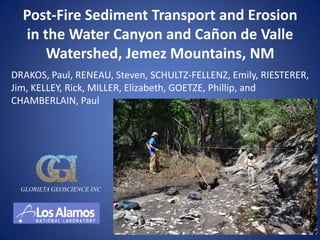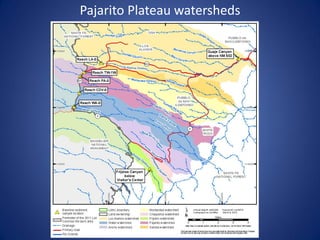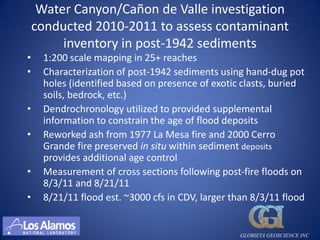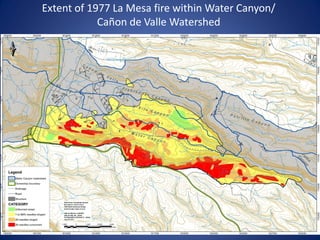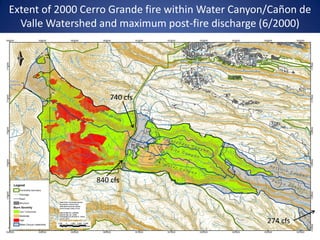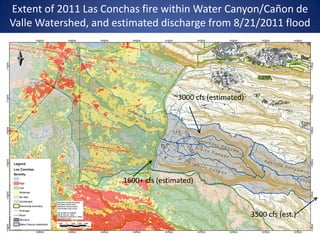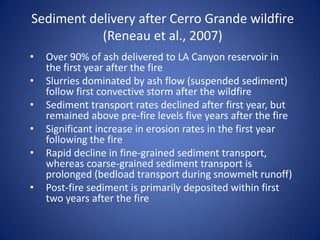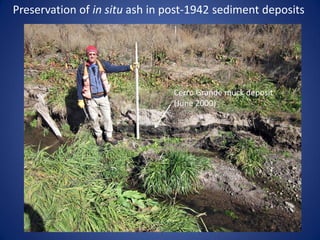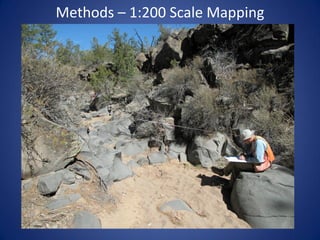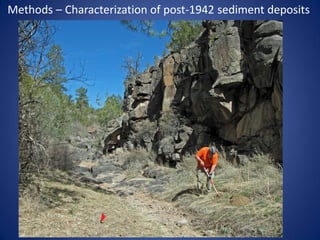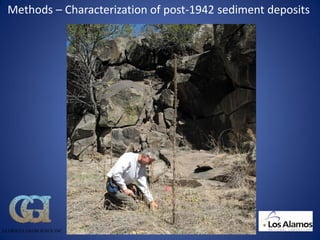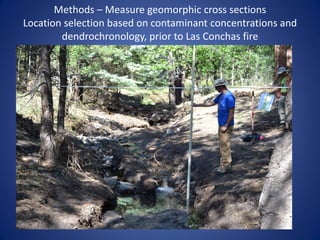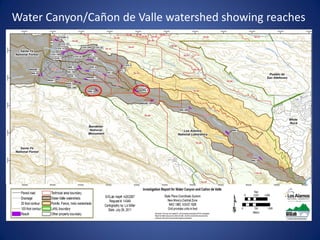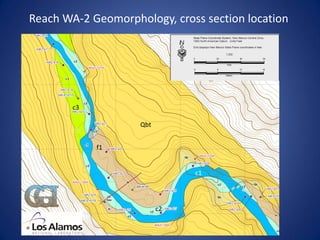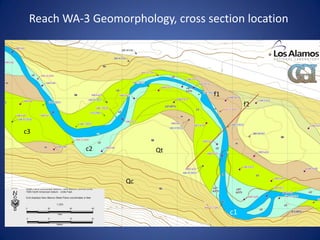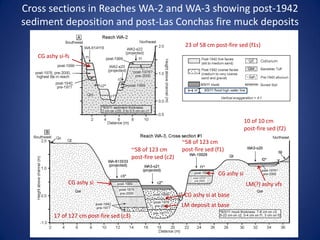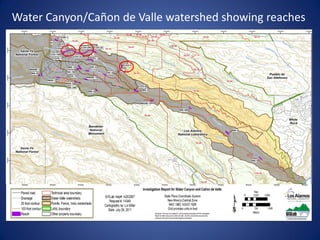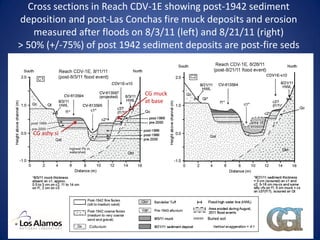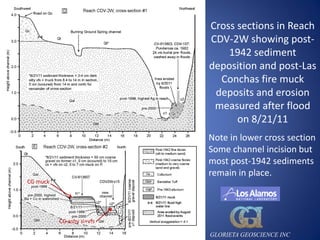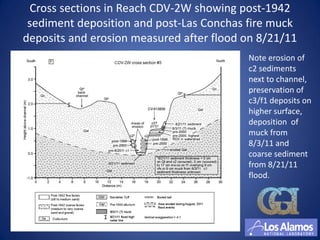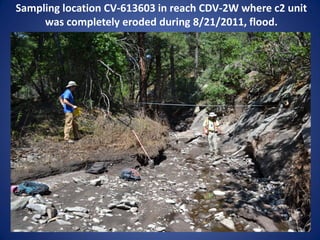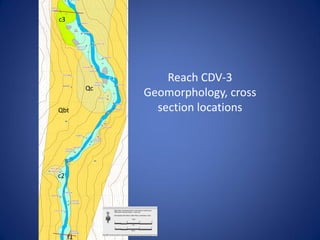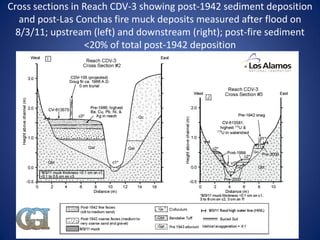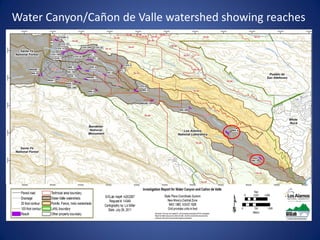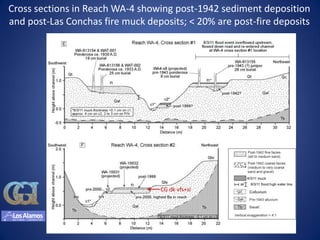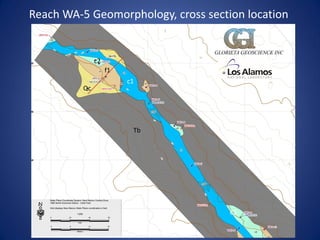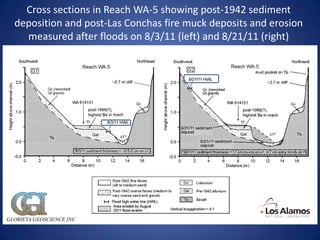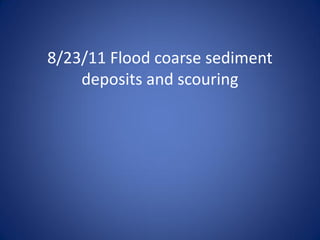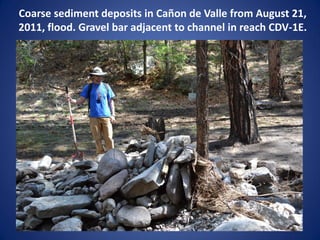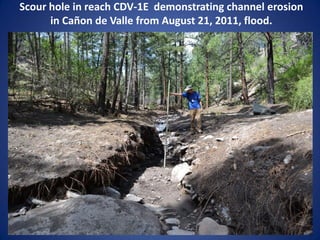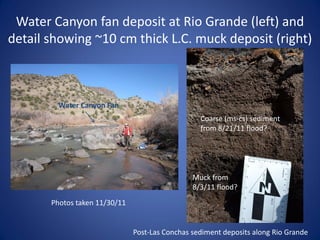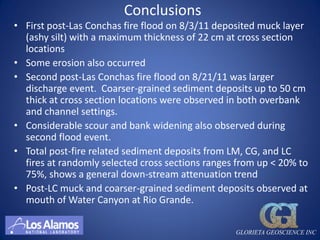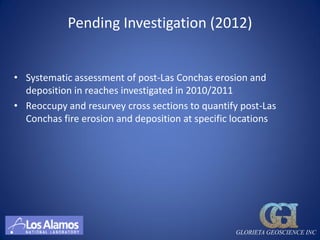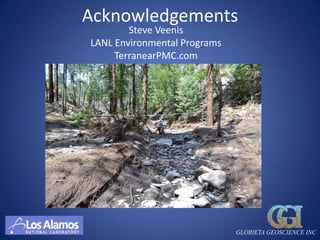Post-Fire Sediment Transport and Erosion in the Water Canyon and Canon de Valle Watershed, Jamez Mountains, NM
- 1. Post-Fire Sediment Transport and Erosion in the Water Canyon and Ca├▒on de Valle Watershed, Jemez Mountains, NM DRAKOS, Paul, RENEAU, Steven, SCHULTZ-FELLENZ, Emily, RIESTERER, Jim, KELLEY, Rick, MILLER, Elizabeth, GOETZE, Phillip, and CHAMBERLAIN, Paul GLORIETA GEOSCIENCE INC
- 3. Water Canyon/Ca├▒on de Valle investigation conducted 2010-2011 to assess contaminant inventory in post-1942 sediments ŌĆó 1:200 scale mapping in 25+ reaches ŌĆó Characterization of post-1942 sediments using hand-dug pot holes (identified based on presence of exotic clasts, buried soils, bedrock, etc.) ŌĆó Dendrochronology utilized to provided supplemental information to constrain the age of flood deposits ŌĆó Reworked ash from 1977 La Mesa fire and 2000 Cerro Grande fire preserved in situ within sediment deposits provides additional age control ŌĆó Measurement of cross sections following post-fire floods on 8/3/11 and 8/21/11 ŌĆó 8/21/11 flood est. ~3000 cfs in CDV, larger than 8/3/11 flood GLORIETA GEOSCIENCE INC
- 4. Extent of 1977 La Mesa fire within Water Canyon/ Ca├▒on de Valle Watershed
- 5. Extent of 2000 Cerro Grande fire within Water Canyon/Ca├▒on de Valle Watershed and maximum post-fire discharge (6/2000) 740 cfs 840 cfs 274 cfs
- 6. Extent of 2011 Las Conchas fire within Water Canyon/Ca├▒on de Valle Watershed, and estimated discharge from 8/21/2011 flood ~3000 cfs (estimated) 1600+ cfs (estimated) 3500 cfs (est.)
- 7. Sediment delivery after Cerro Grande wildfire (Reneau et al., 2007) ŌĆó Over 90% of ash delivered to LA Canyon reservoir in the first year after the fire ŌĆó Slurries dominated by ash flow (suspended sediment) follow first convective storm after the wildfire ŌĆó Sediment transport rates declined after first year, but remained above pre-fire levels five years after the fire ŌĆó Significant increase in erosion rates in the first year following the fire ŌĆó Rapid decline in fine-grained sediment transport, whereas coarse-grained sediment transport is prolonged (bedload transport during snowmelt runoff) ŌĆó Post-fire sediment is primarily deposited within first two years after the fire
- 8. Preservation of in situ ash in post-1942 sediment deposits Cerro Grande muck deposit (June 2000)
- 9. Methods ŌĆō 1:200 Scale Mapping
- 10. Methods ŌĆō Characterization of post-1942 sediment deposits
- 11. Methods ŌĆō Characterization of post-1942 sediment deposits GLORIETA GEOSCIENCE INC
- 12. Methods ŌĆō Measure geomorphic cross sections Location selection based on contaminant concentrations and dendrochronology, prior to Las Conchas fire
- 13. Water Canyon/Ca├▒on de Valle watershed showing reaches
- 14. Reach WA-2 Geomorphology, cross section location c3 Qbt f1 c1 c2
- 15. Reach WA-3 Geomorphology, cross section location f1 f2 c3 c2 Qt Qc c1 c1
- 16. Cross sections in Reaches WA-2 and WA-3 showing post-1942 sediment deposition and post-Las Conchas fire muck deposits 23 of 58 cm post-fire sed (f1s) CG ashy si-fs 10 of 10 cm post-fire sed (f2) ~58 of 123 cm ~58 of 123 cm post-fire sed (f1) post-fire sed (c2) CG ashy si CG ashy si LM(?) ashy vfs CG ashy si at base LM deposit at base 17 of 127 cm post-fire sed (c3)
- 17. Water Canyon/Ca├▒on de Valle watershed showing reaches
- 18. Cross sections in Reach CDV-1E showing post-1942 sediment deposition and post-Las Conchas fire muck deposits and erosion measured after floods on 8/3/11 (left) and 8/21/11 (right) > 50% (+/-75%) of post 1942 sediment deposits are post-fire seds CG muck at base CG ashy si
- 19. Cross sections in Reach CDV-2W showing post- 1942 sediment deposition and post-Las Conchas fire muck deposits and erosion measured after flood on 8/21/11 Note in lower cross section Some channel incision but most post-1942 sediments remain in place. CG muck CG ashy si+vfs GLORIETA GEOSCIENCE INC
- 20. Cross sections in Reach CDV-2W showing post-1942 sediment deposition and post-Las Conchas fire muck deposits and erosion measured after flood on 8/21/11 Note erosion of c2 sediments next to channel, preservation of c3/f1 deposits on higher surface, deposition of muck from 8/3/11 and coarse sediment from 8/21/11 flood.
- 21. Sampling location CV-613603 in reach CDV-2W where c2 unit was completely eroded during 8/21/2011, flood.
- 22. c3 c1 Reach CDV-3 Qc Geomorphology, cross Qbt section locations c2 f1
- 23. Cross sections in Reach CDV-3 showing post-1942 sediment deposition and post-Las Conchas fire muck deposits measured after flood on 8/3/11; upstream (left) and downstream (right); post-fire sediment <20% of total post-1942 deposition
- 24. Water Canyon/Ca├▒on de Valle watershed showing reaches
- 25. Cross sections in Reach WA-4 showing post-1942 sediment deposition and post-Las Conchas fire muck deposits; < 20% are post-fire deposits CG dk vfs+si
- 26. Reach WA-5 Geomorphology, cross section location GLORIETA GEOSCIENCE INC c2 f1 c1 Qc Tb c1
- 27. Cross sections in Reach WA-5 showing post-1942 sediment deposition and post-Las Conchas fire muck deposits and erosion measured after floods on 8/3/11 (left) and 8/21/11 (right) GLORIETA GEOSCIENCE INC
- 28. 8/23/11 Flood coarse sediment deposits and scouring
- 29. Coarse sediment deposits in Ca├▒on de Valle from August 21, 2011, flood. Gravel bar adjacent to channel in reach CDV-1E.
- 30. Coarse sediment deposits in Ca├▒on de Valle from 8/21/2011 flood. ~2 to 4 m wide gravel deposit buries 0.5m wide channel in Reach CDV-2W
- 31. Scour hole in reach CDV-1E demonstrating channel erosion in Ca├▒on de Valle from August 21, 2011, flood.
- 32. Water Canyon fan deposit at Rio Grande (left) and detail showing ~10 cm thick L.C. muck deposit (right) Water Canyon Fan Coarse (ms-cs) sediment from 8/21/11 flood? Muck from 8/3/11 flood? Photos taken 11/30/11 Post-Las Conchas sediment deposits along Rio Grande
- 33. Conclusions ŌĆó First post-Las Conchas fire flood on 8/3/11 deposited muck layer (ashy silt) with a maximum thickness of 22 cm at cross section locations ŌĆó Some erosion also occurred ŌĆó Second post-Las Conchas fire flood on 8/21/11 was larger discharge event. Coarser-grained sediment deposits up to 50 cm thick at cross section locations were observed in both overbank and channel settings. ŌĆó Considerable scour and bank widening also observed during second flood event. ŌĆó Total post-fire related sediment deposits from LM, CG, and LC fires at randomly selected cross sections ranges from up < 20% to 75%, shows a general down-stream attenuation trend ŌĆó Post-LC muck and coarser-grained sediment deposits observed at mouth of Water Canyon at Rio Grande. GLORIETA GEOSCIENCE INC
- 34. Pending Investigation (2012) ŌĆó Systematic assessment of post-Las Conchas erosion and deposition in reaches investigated in 2010/2011 ŌĆó Reoccupy and resurvey cross sections to quantify post-Las Conchas fire erosion and deposition at specific locations GLORIETA GEOSCIENCE INC
- 35. Acknowledgements Steve Veenis LANL Environmental Programs TerranearPMC.com GLORIETA GEOSCIENCE INC

